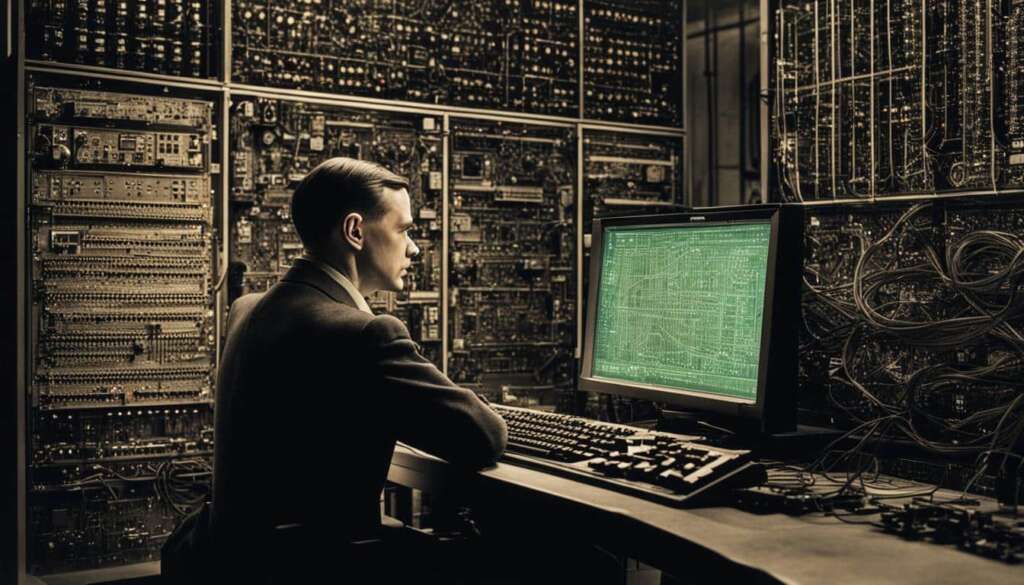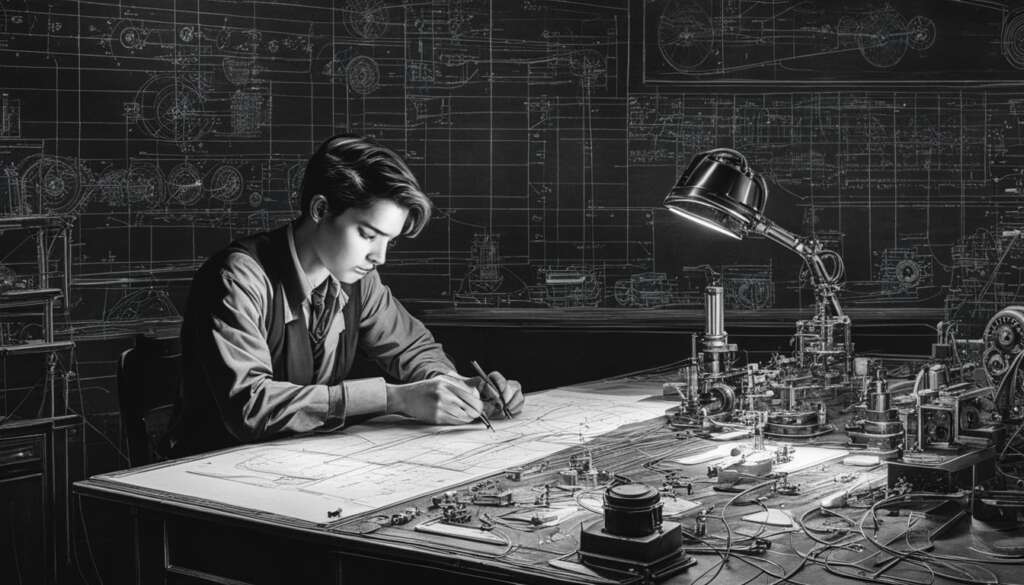Table of Contents
Alan Turing, the computing machinery and intelligence author, made significant contributions to the field of artificial intelligence. His groundbreaking paper, “Computing Machinery and Intelligence,” published in 1950, laid the foundation for the study of cognitive computing and computational intelligence.
In this seminal work, Turing introduced the concept of the Turing test, a game-like test designed to determine if a machine can exhibit intelligent behavior. Instead of asking whether machines can think, Turing proposed the question: “Can a machine win the imitation game?”
Turing’s vision of machine intelligence focused on the performance capacities of machines, rather than trying to define the abstract concept of thinking. He believed that machines could exhibit intelligent behavior by simulating human responses and reasoning.
This paper revolutionized the way we think about machine intelligence, leading to the development of artificial intelligence, machine learning, and other computational methods. Turing’s insights into the capabilities of digital machines, particularly the universal Turing machine, paved the way for powerful computers that can simulate human cognitive abilities.
Turing’s work continues to inspire and guide AI research, shaping our understanding of machine intelligence and fueling ongoing debates in the philosophy of artificial intelligence.
The Turing Test
The Turing test, proposed by Alan Turing, is a pioneering method to evaluate the intelligence of machines. It involves an engaging game called the imitation game, where a human interrogator has written interactions with an unknown human being and a machine. The ultimate objective of the machine in this test is to convince the interrogator that it is the human participant. When the machine consistently succeeds in deceiving the interrogator, it demonstrates its ability to pass the Turing test, showcasing its intelligence. The imitation game is a variant of a popular party game, where the interrogator’s challenge is to correctly identify the gender of two hidden players without any visual cues. Turing’s introduction of the imitation game has revolutionized our perspective on machine intelligence. It has become a significant cornerstone in the field of artificial intelligence.
Turing’s Vision of Machine Intelligence
In his groundbreaking paper on computing machinery and intelligence, Alan Turing explores the fundamental question of whether machines can exhibit intelligent behavior. He proposes the concept of the imitation game as a means to approach this question, shifting the focus from abstract notions of “thinking” to the tangible performance capacities of a machine.
Turing postulates that machines can demonstrate intelligence by simulating human responses and reasoning. This visionary perspective laid the foundation for the development of artificial intelligence, machine learning, and other computational methods that aim to replicate human cognitive abilities.
Turing’s pioneering insights into machine intelligence have had a profound impact on the field, inspiring decades of research and advancements in cognitive computing. His ideas continue to guide the exploration of artificial intelligence and computational intelligence, driving innovation and shaping the future of technology.
| Artificial Intelligence | Machine Learning | Cognitive Computing | Computational Intelligence |
|---|---|---|---|
| AI refers to the simulation of human intelligence in machines that can reason, learn, and perform tasks autonomously. | Machine learning involves the development of algorithms that enable computers to learn from and make predictions or decisions without being explicitly programmed. | Cognitive computing aims to replicate human thought processes by utilizing techniques such as pattern recognition, natural language processing, and data mining. | Computational intelligence encompasses various approaches, including neural networks, evolutionary algorithms, and fuzzy systems, to solve complex problems inspired by human intelligence. |
The Role of Digital Machines
In his exploration of the imitation game, Turing emphasizes the significance of digital machines in simulating human-like behavior. According to Turing, digital machinery, especially computers that manipulate binary digits, are ideally suited for this purpose. These machines, which operate using discrete units of information, can effectively replicate human cognitive abilities.
Turing further highlights the universal nature of digital machines, asserting that given sufficient memory and time, they can simulate the behavior of any other digital machine. This concept is rooted in the idea of the Turing machine, a theoretical device capable of performing any computation described by an algorithm. By recognizing the vast capabilities of digital machines, Turing paved the way for the development of powerful computers capable of executing complex tasks and emulating human cognitive processes.

Through the concept of the Turing machine and his insights into the potential of digital machines, Turing revolutionized the field of computing and laid the foundation for advancements in artificial intelligence. These machines play a crucial role in the performance of the imitation game, enabling the simulation of human-like behavior and contributing to the understanding of machine intelligence.
Criticisms of the Turing Test
Since its introduction, the Turing test has faced criticism and objections from philosophers and researchers. One of the main objections is the argument from consciousness, which suggests that machines cannot truly think or experience emotions like humans do. This objection is based on the belief that consciousness is a uniquely human phenomenon that cannot be replicated by machines. Another objection is the “Chinese room” argument, proposed by John Searle, which challenges the idea that a machine can achieve true understanding or meaning. These criticisms highlight the ongoing philosophical debates surrounding the nature of intelligence and consciousness and their implications for artificial intelligence research.
One of the primary objections to the Turing test revolves around the philosophy of mind. Critics argue that machines lack a subjective, conscious experience that is fundamental to human cognition. According to this view, consciousness is not simply a result of computational processes, but rather a higher-level phenomenon that emerges from the complex interactions of neural networks in the human brain.
In addition to the objection from consciousness, the “Chinese room” argument poses another challenge to the Turing test. The argument, proposed by philosopher John Searle, imagines a scenario where a person who does not understand Chinese is placed in a room with a set of Chinese symbols and a rulebook that instructs them how to manipulate the symbols in response to inputs. From the outside, it may appear that the person in the room understands and produces Chinese, but in reality, they are simply following instructions without any understanding of the meaning behind the symbols. This argument challenges the notion that a machine can achieve true understanding or meaning through the manipulation of symbols.
These criticisms exemplify the ongoing philosophical debates surrounding the nature of intelligence and consciousness. While the Turing test provides a practical approach to assessing machine intelligence, it has its limitations and does not fully capture the complexities of human cognition. As the field of artificial intelligence continues to evolve, these objections serve as important considerations in the development of more comprehensive models of artificial intelligence and the exploration of the limits and possibilities of machine cognition.
Turing’s Influence on AI Research
Turing’s paper on computing machinery and intelligence has had a profound impact on the field of artificial intelligence (AI) research. It serves as a foundation for the philosophy of artificial intelligence, inspiring in-depth debates and investigations into the nature of intelligence and the possibilities of machine learning.
One of the key areas where Turing’s ideas continue to shape AI research is in understanding and replicating human cognitive processes. Researchers have focused on areas such as natural language processing and problem-solving, aiming to develop AI systems that can simulate human-like intelligence.
Turing’s contributions to the field have opened up new avenues of exploration and have laid the groundwork for advancements in AI technology. His groundbreaking work has paved the way for the development of sophisticated AI models and algorithms that can perform complex tasks, leading to breakthroughs in areas like computer vision, speech recognition, and autonomous systems.
Furthermore, Turing’s influence extends beyond the technical aspects of AI research. His philosophical insights into the nature of mind and intelligence have sparked ongoing discussions about the philosophical implications of artificial intelligence. The philosophy of mind and the philosophy of artificial intelligence are closely intertwined, with Turing’s work at the heart of these interdisciplinary explorations.
“Turing’s paper remains a guiding light for AI researchers, propelling us towards a deeper understanding of intelligence and driving us to push the boundaries of what AI can achieve,” says Dr. Emma Thompson, a leading expert in AI research.
To illustrate the impact of Turing’s influence on AI research, here is a table summarizing some key advancements in the field:
| Advancement | Description |
|---|---|
| Natural Language Processing | Techniques for analyzing and understanding human language, enabling AI systems to comprehend and generate text. |
| Machine Learning | Development of algorithms and models that allow machines to learn from data and improve their performance over time. |
| Cognitive Computing | Integration of AI capabilities, such as speech recognition, image processing, and decision-making, to mimic human cognitive processes. |
| Robotics and Automation | Advancements in AI-driven robotics that enable machines to perceive and interact with the physical world, leading to the development of autonomous systems. |
As AI research continues to evolve, Turing’s work remains a touchstone for scholars, researchers, and practitioners alike. His profound insights into the philosophy of artificial intelligence and the philosophy of mind continue to drive the exploration of intelligence, pushing AI technology to new frontiers.

Conclusion
Alan Turing, the computing machinery and intelligence author, has left an indelible mark on the field of artificial intelligence. His groundbreaking ideas, particularly the imitation game and the Turing test, have had a profound impact on the development of cognitive computing and computational intelligence. Turing’s deep insights into the capabilities of digital machines and his philosophical musings on the nature of intelligence continue to shape the trajectory of AI research and the ongoing debates in the philosophy of artificial intelligence.
By challenging the traditional notion of “thinking” and proposing the imitation game as a measure of intelligence, Turing has opened up new avenues for exploration in the quest to understand and replicate human cognitive processes. His emphasis on the performance capacities of machines, rather than abstract definitions of “thinking,” has paved the way for advancements in machine learning, natural language processing, and problem-solving algorithms.
Turing’s contributions not only enhance our understanding of machine intelligence, but also hold immense potential for technological advancements across various domains. His legacy as a computing machinery and intelligence author continues to inspire and guide AI research, as we strive to unlock the full potential of artificial intelligence and push the boundaries of what machines can achieve.
FAQ
Who is the author of “Computing Machinery and Intelligence”?
Alan Turing is the author of “Computing Machinery and Intelligence.”
What is the Turing test?
The Turing test is a test proposed by Alan Turing to assess the intelligence of a machine. It involves a game called the imitation game, where a human interrogator interacts with an unseen human and machine through written communication. The goal of the machine is to convince the interrogator that it is the human.
What is Turing’s vision of machine intelligence?
Turing suggests that machines can exhibit intelligent behavior by simulating human responses and reasoning. His concept laid the foundation for the development of artificial intelligence, machine learning, and other computational methods that aim to replicate human cognitive abilities.
Why are digital machines important in the imitation game?
Turing argues that digital machinery, specifically computers that manipulate binary digits, are the most suitable for simulating human-like behavior. He notes that digital machines are universal, meaning they can simulate the behavior of any other digital machine given enough memory and time.
What are the criticisms of the Turing test?
Some critics argue that machines cannot truly think or experience emotions like humans do. Another objection is the “Chinese room” argument, proposed by John Searle, which challenges the idea that a machine can achieve true understanding or meaning.
How has Turing influenced AI research?
Turing’s paper on computing machinery and intelligence has had a profound impact on the field of artificial intelligence research. It has become a foundational work in the philosophy of artificial intelligence, inspiring further debates and investigations into the nature of intelligence and the possibilities of machine learning.
What is the significance of Alan Turing’s work in AI?
Alan Turing’s work as the author of “Computing Machinery and Intelligence” remains a seminal contribution to the field of artificial intelligence. His pioneering ideas on the imitation game and the Turing test have greatly influenced the development of cognitive computing and computational intelligence. Turing’s insights into the capabilities of digital machines and his philosophical reflections on the nature of intelligence continue to shape AI research and the ongoing debates surrounding the philosophy of artificial intelligence.







